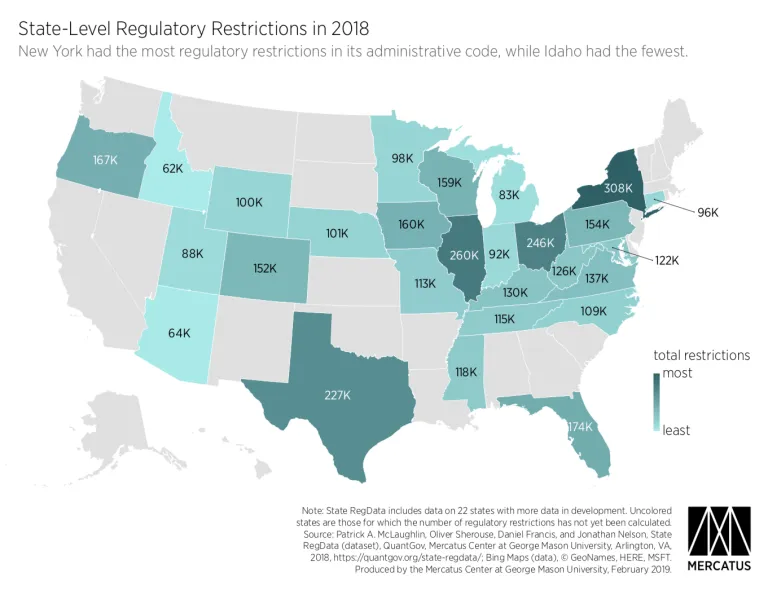- | Expert Commentary Expert Commentary
- |
Quarterly Economic Update, Micromobility Transportation Innovation, and 5G
Research Round-Up: March 4, 2019
The Economic Situation, March 2019
Bruce Yandle | Policy Brief
From the brief: "America is now well into 2019’s first quarter, and 2018’s much-celebrated Goldilocks economy seems to be a thing of the past. After a bruising government shutdown, and with ongoing trade war negotiations, a Federal Reserve (Fed) that seems to be changing horses—from higher to lower interest rates—midstream, and a slowing world economy, uncertainty is rising and forecasters are understandably trimming back expectations for the year. The most recent 2.6 percent reading for fourth-quarter GDP growth, which broke the previous 3.0 percent trend, may be an accurate harbinger of what Americans will see for the year.”
Embracing Innovation in Micromobility Transportation
Jennifer Huddleston | Public Interest Comment
From the comment: "The most innovation-friendly approach would provide a broad definition for this sort of means of transportation in order to allow the development of new micromobility options without requiring regulatory updates from policymakers. Such a governance approach would encourage innovators to think even more creatively and would send a clear message to the public that the state legislature is inclined to embrace in the future all potential solutions in the area of transportation.”
Better Health for More People at Lower Cost, Year after Year
Matthew D. Mitchell, Anne Philpot, Robert Graboyes, Darcy N. Bryan, MD, Jared Rhoads, Edward J. Timmons, and Thomas Stratmann | Congressional Testimony
From the cover letter: "The more one dives into the numbers, the more obvious it is that the sky is not falling on American healthcare. But America could still do far, far better than it does at present. A traditional assault on waste, fraud, and abuse will almost certainly leave Americans disappointed. Though all three problems exist in American healthcare, their severity and solvability are likely exaggerated in the minds of many medical professionals and laypeople. Unless America allows markets to find new and innovative ways of delivering care, the cost of reducing waste, fraud, and abuse will almost certainly eat away a large percentage of whatever savings America realizes through those efforts.”
5G Basics and Public Policy
Brent Skorup | Policy Brief
From the brief: "5G and other wireless services need infrastructure, including fiber networks and roadside poles to install on. All infrastructure projects on public property require local permitting and fees. Current local regulations were typically made for a different world—a few cell towers in a town, not hundreds of wireless facilities dotting downtowns and roadways—and the permitting and fee process is excessive. The FCC recently identified one case where a small California city charged a company $60,000 in application fees to install 16 small wireless sites, only to reject the application and charge the company for $350,000 in attorney’s fees. In many towns and cities, it takes years to process an application. Though these are extreme cases, the FCC found that excessive delays and fees are common nationwide.”
“One way to build infrastructure quickly and put pricing pressure on city fees is to encourage the construction of 5G and other wireless infrastructure on private property, such as backyards, balconies, and grain silos. Localities could make new antenna installations on private property expensive because the law is unclear about what rights property owners have. The FCC and state governments have authority to prevent most municipal interference with and fees on antenna installations on private property, but the FCC could use additional congressional permission and encouragement. State lawmakers can also protect homeowners from any unnecessary local regulations on antenna installation.”
Achieving a Modern Regulatory System in Ohio
James Broughel | State Testimony
From the testimony: "The state of Ohio had more than 246,000 regulatory restrictions on its books as of early 2018. It has more regulation than all of its immediate neighbors, based on findings from the Mercatus Center’s State RegData project. A budgeting system for regulations could help prevent unwanted regulatory accumulation in Ohio, while also granting regulators the flexibility to address new and evolving problems. The successful experience of British Columbia since 2001 offers a roadmap for how to implement such a reform. Other US states such as Kentucky and Virginia are following British Columbia’s successful example.”
“If Ohio can consistently increase its economic growth rate each year, this would have profound implications for the opportunities available to state residents, both in the near term as well as far into the future. Establishing a regulatory budget is a smart step toward achieving this goal.”
Mapping Regulatory Restrictions in US States
Mark Febrizio and Patrick McLaughlin | Chart
From the publication: "At the time of this writing, State RegData includes data on 22 states with more in development. Unsurprisingly, State RegData reports significant variety in the amount of regulation among states. New York, the most regulated state in the dataset, has 307,636 restrictions in its administrative code. Illinois, Ohio, and Texas all have more than 200,000 regulatory restrictions. At the other end of the spectrum, Arizona’s regulatory burden is merely 63,919 restrictions. Connecticut, Michigan, Minnesota, and Utah also have fewer than 100,000 restrictions in their administrative codes. Below is a graphical presentation of the current number of regulatory restrictions (in thousands) across the United States.”
